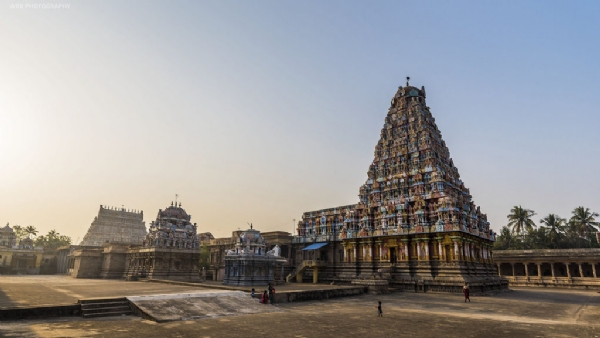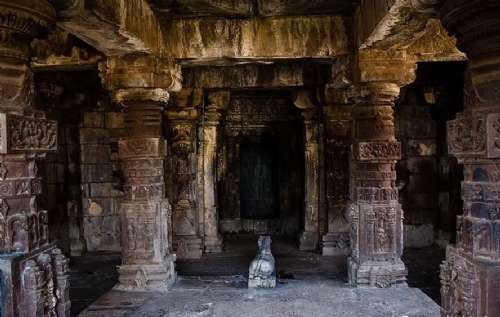Kampaheswarar temple: the centuries old shrine dedicated to Lord Shiva
08 Feb 2022 16:25:46
There is no limit to the beauty which the temples in South India possess, along with the most interesting legends attached to them. Each one comes with a tale, narrating the roots of place. The temple we will look at today, is no exception. Located in Thirubuvanam, just 9 kms from Kumbakonam in Tamil Nadu, Kampaheswarar Temple, also called Sarabeswarar temple, is an ancient Shaivite temple which is flocked by devotees from all over the world, throughout the year. It is enshrined by Lord Shiva. Legend has it that Lord Shiva once relieved a king of quaking or kampa, as he was being haunted by an evil spirit, Brahmarakshasa, of a Brahmin who he killed accidentally.


There are inscriptions in Tamil from the period of Jatavarman Tribuvanachakravarthin Parakrama Pandyadeva registered by Epigraphy Department in 1911. 159 registers a contract between the residents of Tribhuvanavirapuram and Kulamangalanadu, who were urkaval or watchmen, of the village. On the same place, the inscription numbered 160, records a similar contract in the presence of chief Udaiyar Kulasekharadeva.
A sculpture of Sarabeswara murti in Tribhuvanam, (a Shiva temple in Tanjore) is depicted with 3 legs, and body and face of a lion, and a tail. It has four human arms, the right upper hand holds axe, a noose is held in the lower right hand, the deer in upper left hand and fire in the lower left hand. Narasimha is shown with 8 arms, flaying and struggling under Sharbeshwaramurti’s feet. The shrine has sculptures of Sridevi and Bhudevi, the consorts of Vishnu.

Ever since then, Lord Shiva came to be known as Kampaheswarar and was worshipped in the same form at the temple. The Shiva linga is installed in the garbhagriha of the sanctum sanctorum on an elevated platform.
Besides the chief deity, the temple also houses an enormous shrine for Sarbeswarar. As per legend, the He saved the celestial deities from the wrath of Vishnu in the form of Narasimha after he killed Hiranyakasibu. Built in the traditional Dravidian style architecture, the temple also houses beautiful sculptures of Sridevi and Bhudevi - consorts of Lord Vishnu.
History | The history of the temple goes back to the 1176 CE at the time of Kulottunga-Chola III. The inscriptions found in the chief shrine are different from those found in the outer gopuram. This suggests that while the construction of the temple began during the reign of Kulottunga- Chola III, it was completed by the later Chola kings, most probably the Kulottunga-Choladeva. According to inscriptions found in the south wall of the temple, the shrine was constructed by Kulothunga Chola III, as a memorial of his successful North Indian campaign.
Also Read | Gangaikonda Cholapuram temple: The ancient pride of the Chola dynasty!
The inscriptions in the shrine of the presiding deity are similar to the one in the outer gopuram (gateway tower), which indicates the building of the temple by Kulottunga-Choladeva. While it is unclear which Kulottunga it is, scholars have placed it at 1176 CE, which is closer to the reign of Kulothunga Chola III, who is believed to have been the last powerful Chola king. There are four inscriptions from Kulothunga Chola in Grantha script.

The inscription 189 of 1907, the one on the southern wall of the central shrine, is damaged but mentions Arya Sri-Somanatha. Inscription 190 on the same wall shows the building operations of Kulothunga Chola. 191, at entrance of the outer gopuram, is a duplicate of the 190. On the same gopura, inscription 192 indicates record of king Kulothunga Chola.
There are inscriptions in Tamil from the period of Jatavarman Tribuvanachakravarthin Parakrama Pandyadeva registered by Epigraphy Department in 1911. 159 registers a contract between the residents of Tribhuvanavirapuram and Kulamangalanadu, who were urkaval or watchmen, of the village. On the same place, the inscription numbered 160, records a similar contract in the presence of chief Udaiyar Kulasekharadeva.
Also Read | Mandore Gardens: the abandoned beauty of Jodhpur
In the temple, apart from Lord Shiva’s shrine, there is a whole separate shrine for Sarabeswara, who is blend of man, eagle and lion. He was believed to have relieved the devas from the fury of Vishnu in the form of Narasimha, after he slayed Hiranyakasibu.
A sculpture of Sarabeswara murti in Tribhuvanam, (a Shiva temple in Tanjore) is depicted with 3 legs, and body and face of a lion, and a tail. It has four human arms, the right upper hand holds axe, a noose is held in the lower right hand, the deer in upper left hand and fire in the lower left hand. Narasimha is shown with 8 arms, flaying and struggling under Sharbeshwaramurti’s feet. The shrine has sculptures of Sridevi and Bhudevi, the consorts of Vishnu.
